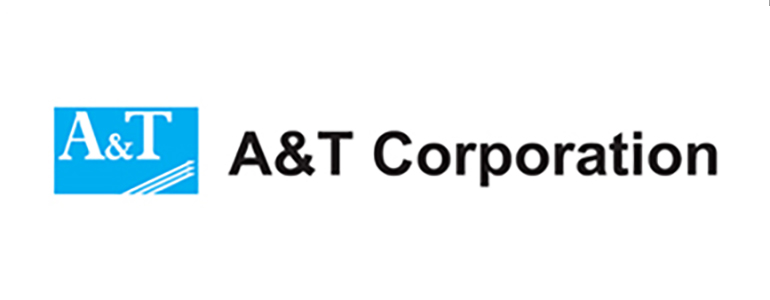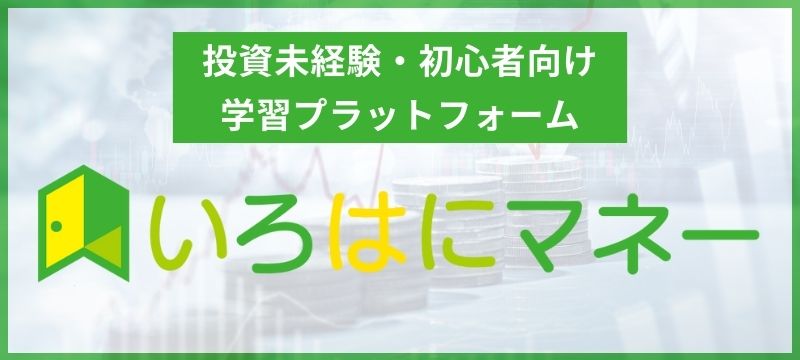| A&T Corporation (6722) |
|
||||||||
Company |
A&T Corporation |
||
Code No. |
6722 |
||
Exchange |
JASDAQ |
||
Industry |
Electrical equipment (manufacturing industry) |
||
President |
Shigetaka Misaka |
||
Address |
Yokohama Plaza Bldg. 2-6 Kinko-cho, Kanagawa-ku, Yokohama-shi |
||
Year-end |
End of December |
||
URL |
|||
*The share price is the closing price on August 22, 2018. The number of shares issued and BPS are as of the end of 2Q. ROE is from previous term.
|
||||||||||||||||||||||||
|
|
*The forecasted values were provided by the company.
This report outlines A&T Corporation, briefly reports the results for the second quarter of the term ending Dec. 2018, the medium-term management plan, and so on. |
| Key Points |
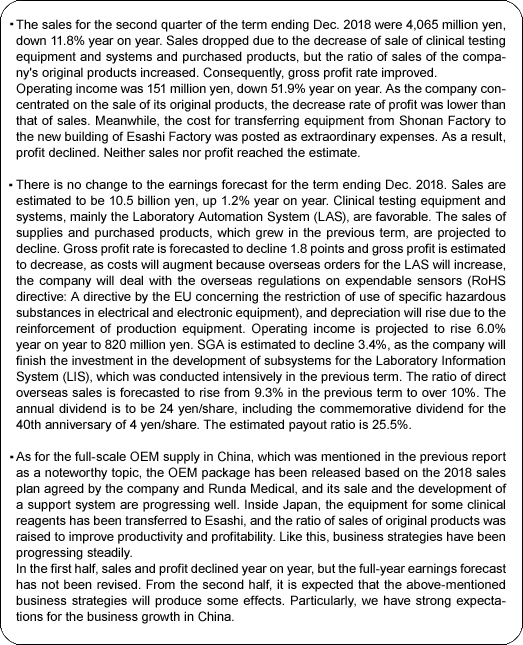 |
| Company Overview |
|
The core businesses of A&T Corporation are the "blood testing business," in which the company develops, manufactures, and sells IVD devices, reagents, etc. mainly for electrolyte and glucose tests, and the "IT and automation support business," which facilitates the streamlining of clinical tests.
The company excels at proposing an optimal one-stop solution for preparing necessary products in a laboratory, installing and operating equipment while proposing a layout, and possesses advanced technologies that are highly evaluated by leading overseas OEM clients.
【1-1 Corporate history】
In the 1980s, the general chemical manufacturer Tokuyama Corporation (4043, 1st section of Tokyo Stock Exchange) was expanding its business scope from materials to fine chemicals. While taking inventory of various technologies and items, Tokuyama Corporation decided to develop latex (rubber material; one of the chemical products) reagents for testing antigen-antibody reactions.
In the development process, Tokuyama Corporation formed a business tie-up with Analytical Instruments Inc., which develops, manufactures, and sells clinical test equipment and had been leading the industry by releasing such products as fully automatic blood sugar analyzer in 1978, and in Apr. 1988, they founded a joint venture for distributing their products, A&T Corporation. ("A" of Analytical Instruments and "T" of Tokuyama were combined.)
In November 1990, the company established Esashi Factory, which is now the primary production site, in Iwate Prefecture.
In 1994, A&T Corporation underwent an absorption-type merger, integrating the diagnosis system division of Tokuyama Corporation. The period from the 1980s to the 1990s was the growth period of the clinical testing industry, in which many core technologies were developed, and the company expanded its business steadily while taking advantage of that trend.
In Jul. 2003, the company issued over-the-counter shares. It is now listed in the JASDAQ market of Tokyo Stock Exchange.
【1-2 Corporate ethos, etc.】
A&T Corporation upholds its corporate ethos: "Support medical care and contribute to people's health around the world," and aims to improve the quality of medical care and reduce cost, under following three management policies.
 * C.A.C.L.: Acronym of "Chemicals (diagnostic reagents)," "Analyzers (Analyzers)," "Computers (laboratory information system)," and "Lab-Logistics (laboratory automation system)" in the field of products required for operating a clinical test room
【1-3 Market environment】
◎ Market scale
(Domestic and global markets)
According to the Fuji Research Institute Corporation, the scale of the Japanese clinical testing market was 501.3 billion yen in 2016, accounting for 6.0% of the scale of the global market, but the market growth is slight, because the growth of immunoserological tests became sluggish. The market scale is estimated to be 519.5 billion yen in 2022, with average annual growth rate being only 0.6%.
Based on the information in the website of the Japan Association of Clinical Reagents Industries, A&T Corporation estimated that the scale of the Japanese market of related devices and reagents is about 590 billion yen. The market scales of clinical chemistry and hematology tests are 195.8 billion yen and 30.6 billion yen, respectively.
On the other hand, also according to the Fuji Research Institute, the global market scale reached about 62.3 billion US dollars (6.23 trillion yen under the assumption that 1 dollar is equivalent to 100 yen) in 2015, and is projected to keep growing at an annual rate of 2.4%, and reach about 70.4 billion US dollars (7.04 trillion yen under the assumption that 1 dollar is equivalent to 100 yen). It is expected that Eastern Europe, Russia, Asia, South America, and Africa, where the testing environment is still to be developed, will lead the growth. It was mentioned that as the Japanese market was already saturated, Japanese manufacturers would try to operate their business in the global market by utilizing their advanced technology and quality based on their stable business bases in Japan. * C.A.C.L.: Acronym of "Chemicals (diagnostic reagents)," "Analyzers (Analyzers)," "Computers (laboratory information system)," and "Lab-Logistics (laboratory automation system)" in the field of products required for operating a clinical test room
【1-3 Market environment】
◎ Market scale
(Domestic and global markets)
According to the Fuji Research Institute Corporation, the scale of the Japanese clinical testing market was 501.3 billion yen in 2016, accounting for 6.0% of the scale of the global market, but the market growth is slight, because the growth of immunoserological tests became sluggish. The market scale is estimated to be 519.5 billion yen in 2022, with average annual growth rate being only 0.6%.
Based on the information in the website of the Japan Association of Clinical Reagents Industries, A&T Corporation estimated that the scale of the Japanese market of related devices and reagents is about 590 billion yen. The market scales of clinical chemistry and hematology tests are 195.8 billion yen and 30.6 billion yen, respectively.
On the other hand, also according to the Fuji Research Institute, the global market scale reached about 62.3 billion US dollars (6.23 trillion yen under the assumption that 1 dollar is equivalent to 100 yen) in 2015, and is projected to keep growing at an annual rate of 2.4%, and reach about 70.4 billion US dollars (7.04 trillion yen under the assumption that 1 dollar is equivalent to 100 yen). It is expected that Eastern Europe, Russia, Asia, South America, and Africa, where the testing environment is still to be developed, will lead the growth. It was mentioned that as the Japanese market was already saturated, Japanese manufacturers would try to operate their business in the global market by utilizing their advanced technology and quality based on their stable business bases in Japan.
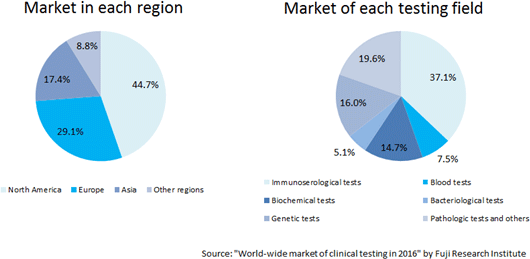 (Trend in each testing field)
Immunoserological testing formed the largest market (37.1%; about 23.1 billion US dollars; about 2.31 trillion yen), and the market of tests mainly for infectious diseases is growing.
The blood testing market, in which A&T Corporation operates business, accounts for 7.5% and has a scale of about 4.7 billion US dollars (about 470 billion yen). In North America, Europe (especially western Europe), and Japan, blood testing has been already diffused, and the market growth is stagnant or slightly increasing. In Asia and other regions, the market is growing, and expected to keep growing steadily, according to the survey.
(Trend of IVD devices)
According to "Statistical Survey on Trends in Pharmaceutical Production" by the Ministry of Health, Labour and Welfare, the scale of the Japanese medical products market (domestic production amount) in 2015 was about 1.9 trillion yen. Products for medical treatment is dominant, and medical Analyzers, which is handled by A&T Corporation, has a market scale of about 180 billion yen.
While there is a significant excess of imports of the overall medical product, there is an excess of exports of IVD devices. This indicates how competitive Japanese companies are. Hitachi and Toshiba supply testing equipment to Roche in Switzerland and Abbott in the U.S., respectively. Likewise, A&T Corporation supplies OEM products to Siemens. Namely, testing equipment made in Japan is now indispensable in the global clinical testing field. (Trend in each testing field)
Immunoserological testing formed the largest market (37.1%; about 23.1 billion US dollars; about 2.31 trillion yen), and the market of tests mainly for infectious diseases is growing.
The blood testing market, in which A&T Corporation operates business, accounts for 7.5% and has a scale of about 4.7 billion US dollars (about 470 billion yen). In North America, Europe (especially western Europe), and Japan, blood testing has been already diffused, and the market growth is stagnant or slightly increasing. In Asia and other regions, the market is growing, and expected to keep growing steadily, according to the survey.
(Trend of IVD devices)
According to "Statistical Survey on Trends in Pharmaceutical Production" by the Ministry of Health, Labour and Welfare, the scale of the Japanese medical products market (domestic production amount) in 2015 was about 1.9 trillion yen. Products for medical treatment is dominant, and medical Analyzers, which is handled by A&T Corporation, has a market scale of about 180 billion yen.
While there is a significant excess of imports of the overall medical product, there is an excess of exports of IVD devices. This indicates how competitive Japanese companies are. Hitachi and Toshiba supply testing equipment to Roche in Switzerland and Abbott in the U.S., respectively. Likewise, A&T Corporation supplies OEM products to Siemens. Namely, testing equipment made in Japan is now indispensable in the global clinical testing field.
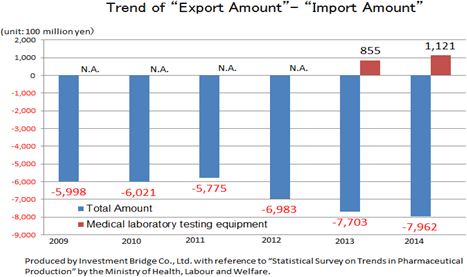 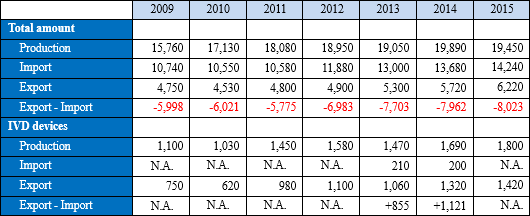 *Unit: 100 million yen. The import amounts of medical Analyzers from 2009 to 2012 and 2015 are N.A., because they were not in the top 10.
◎ Companies in the same field *Unit: 100 million yen. The import amounts of medical Analyzers from 2009 to 2012 and 2015 are N.A., because they were not in the top 10.
◎ Companies in the same field
 *The results for this term were forecasted by the company. The units are million yen, %, and times. Share price-related indices are based on the closing prices on August 22, 2018.
* Sysmex, Hitachi High-Technologies adopted IFRS. Hitachi High-Technologies' operating income is "adjusted operating income" which is calculated by subtracting the cost of sales and selling, general and administrative expenses from sales revenue.
We compared major listed clinical testing device manufacturers. A&T Corporation has the smallest business scale among them and the share price evaluation is the lowest as its price-to-book ratio is under one. It would be necessary to manifest its strategies to enhance popularity and expand business as well as promoting understanding.
【1-4 Business contents】
In addition to the development, manufacturing, and sale of products, including testing devices and reagents used in the clinical testing rooms of hospitals, A&T Corporation offers customer support. The company also offers comprehensive consulting services, including the proposal for the layout of a laboratory, installation and operation. *The results for this term were forecasted by the company. The units are million yen, %, and times. Share price-related indices are based on the closing prices on August 22, 2018.
* Sysmex, Hitachi High-Technologies adopted IFRS. Hitachi High-Technologies' operating income is "adjusted operating income" which is calculated by subtracting the cost of sales and selling, general and administrative expenses from sales revenue.
We compared major listed clinical testing device manufacturers. A&T Corporation has the smallest business scale among them and the share price evaluation is the lowest as its price-to-book ratio is under one. It would be necessary to manifest its strategies to enhance popularity and expand business as well as promoting understanding.
【1-4 Business contents】
In addition to the development, manufacturing, and sale of products, including testing devices and reagents used in the clinical testing rooms of hospitals, A&T Corporation offers customer support. The company also offers comprehensive consulting services, including the proposal for the layout of a laboratory, installation and operation.
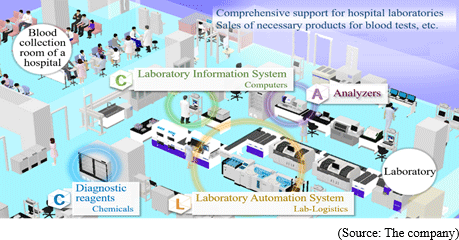 (What is clinical testing?)
Clinical tests can be classified into "biopsies" for directly examining the body with medical equipment, such as X-ray equipment, CT, MRI, electrocardiographic and ultrasonic equipment, and "laboratory tests" for examining biological samples (specimens), such as blood, urine, stool, and cells, collected from patients.
A&T Corporation handles products used for laboratory testing, especially blood tests.
There are a variety of blood tests conducted at hospitals and in comprehensive medical checkups, including the tests of the hepatic system, the renal system, uric acid, the lipid system, glucose metabolism, blood cells, and infectious diseases. A&T Corporation mainly conducts business related to "electrolyte tests" and "glucose tests."
"Electrolyte tests"
The water content constitutes about 60% of the human body, as body fluids, including intracellular fluid and blood plasma. Body fluids are classified into electrolytes, which are mineral ions that dissolve in water and conduct electricity (such as sodium, potassium, calcium, and chlorine), and non-electrolytes, which dissolve in water, but do not conduct electricity (such as glucose and urea).
Each electrolyte takes important roles for keeping human beings alive while maintaining a healthy balance - "sodium" adjusts the water content of the body, "potassium" controls muscles and nerves, "calcium" forms bones and teeth, conveys nervous stimuli, and coagulates blood, and "chlorine" supplies oxygen to the inside of the body. If the concentration of electrolytes in blood is abnormal, there is a possibility that the kidneys or hormones are malfunctioning.
The purpose of electrolyte tests is to measure the concentration of each electrolyte ion in body fluid, detect the disruption of a balance, and then diagnose a disorder in the body. Sampled blood and urine are examined with testing device. (What is clinical testing?)
Clinical tests can be classified into "biopsies" for directly examining the body with medical equipment, such as X-ray equipment, CT, MRI, electrocardiographic and ultrasonic equipment, and "laboratory tests" for examining biological samples (specimens), such as blood, urine, stool, and cells, collected from patients.
A&T Corporation handles products used for laboratory testing, especially blood tests.
There are a variety of blood tests conducted at hospitals and in comprehensive medical checkups, including the tests of the hepatic system, the renal system, uric acid, the lipid system, glucose metabolism, blood cells, and infectious diseases. A&T Corporation mainly conducts business related to "electrolyte tests" and "glucose tests."
"Electrolyte tests"
The water content constitutes about 60% of the human body, as body fluids, including intracellular fluid and blood plasma. Body fluids are classified into electrolytes, which are mineral ions that dissolve in water and conduct electricity (such as sodium, potassium, calcium, and chlorine), and non-electrolytes, which dissolve in water, but do not conduct electricity (such as glucose and urea).
Each electrolyte takes important roles for keeping human beings alive while maintaining a healthy balance - "sodium" adjusts the water content of the body, "potassium" controls muscles and nerves, "calcium" forms bones and teeth, conveys nervous stimuli, and coagulates blood, and "chlorine" supplies oxygen to the inside of the body. If the concentration of electrolytes in blood is abnormal, there is a possibility that the kidneys or hormones are malfunctioning.
The purpose of electrolyte tests is to measure the concentration of each electrolyte ion in body fluid, detect the disruption of a balance, and then diagnose a disorder in the body. Sampled blood and urine are examined with testing device.
 "Glucose tests"
The sugar in blood plasma (blood sugar) is composed mostly of glucose, which is the only energy source for the central nervous system, including the cerebrum. When the stomach is empty (over 5 hours after eating), the liver emits about 8 grams of glucose per hour, and the brain consumes about half of them, and muscles and red blood cells consume one fourth of them, respectively.
Blood sugar level in its normal condition is strictly controlled while keeping a balance between the increase through the absorption from the intestine and the generation in the liver and the decrease through the consumption in the muscles. If this control does not work properly, hyperglycemia or hypoglycemia will occur.
A glucose test is conducted for measuring the concentration of glucose in blood or urine. "Glucose tests"
The sugar in blood plasma (blood sugar) is composed mostly of glucose, which is the only energy source for the central nervous system, including the cerebrum. When the stomach is empty (over 5 hours after eating), the liver emits about 8 grams of glucose per hour, and the brain consumes about half of them, and muscles and red blood cells consume one fourth of them, respectively.
Blood sugar level in its normal condition is strictly controlled while keeping a balance between the increase through the absorption from the intestine and the generation in the liver and the decrease through the consumption in the muscles. If this control does not work properly, hyperglycemia or hypoglycemia will occur.
A glucose test is conducted for measuring the concentration of glucose in blood or urine.
 1. Business Field
The business of A&T Corporation is composed of the "blood testing business," in which the company develops, manufactures, and sells clinical testing devices, reagents, supplies, etc. for blood tests, and the "IT and automation support business," which facilitates the streamlining of manual work in hospital laboratories with IT and automated systems. The company comprehensively supports hospital laboratories.
(Since this company conducts this business only, neither its brief financial reports nor securities reports contain segment information. It should be noted that the company discloses the sales of each product series in reference materials for briefing results, etc., but not the sales of each type of business.) 1. Business Field
The business of A&T Corporation is composed of the "blood testing business," in which the company develops, manufactures, and sells clinical testing devices, reagents, supplies, etc. for blood tests, and the "IT and automation support business," which facilitates the streamlining of manual work in hospital laboratories with IT and automated systems. The company comprehensively supports hospital laboratories.
(Since this company conducts this business only, neither its brief financial reports nor securities reports contain segment information. It should be noted that the company discloses the sales of each product series in reference materials for briefing results, etc., but not the sales of each type of business.)
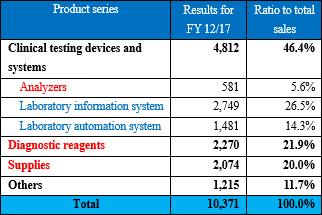 The red letters denote the "Blood testing business" (analyzers, diagnostic reagents, and supplies), while the blue letters denote the "IT and automation support business" (Laboratory Information System, Laboratory Automation System). The sales distribution ratio for the term ended Dec. 2017 was 47.5% for the blood testing business, and 40.8% for the IT and automation support business. The red letters denote the "Blood testing business" (analyzers, diagnostic reagents, and supplies), while the blue letters denote the "IT and automation support business" (Laboratory Information System, Laboratory Automation System). The sales distribution ratio for the term ended Dec. 2017 was 47.5% for the blood testing business, and 40.8% for the IT and automation support business.
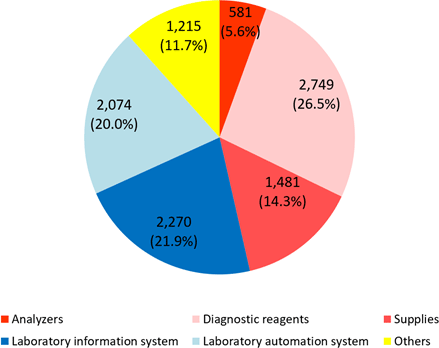 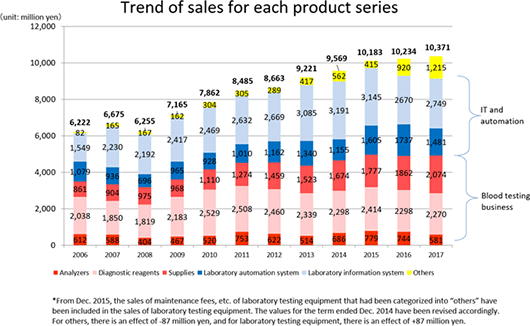 (1) Blood testing business
(Outline)
The company works on developing, manufacturing, and selling Analyzers for clinical trials such as "electrolyte tests" and "glucose tests," reagents for clinical tests (for measuring the concentrations of electrolytes, blood sugar, etc.), and supplies (such as sensors installed in analyzer), and offers customer support. (1) Blood testing business
(Outline)
The company works on developing, manufacturing, and selling Analyzers for clinical trials such as "electrolyte tests" and "glucose tests," reagents for clinical tests (for measuring the concentrations of electrolytes, blood sugar, etc.), and supplies (such as sensors installed in analyzer), and offers customer support.
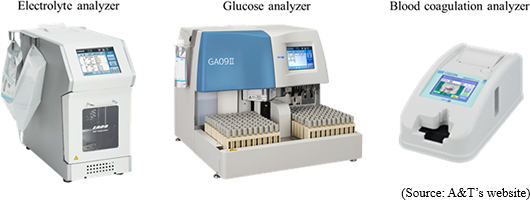 (Commercial distribution)
*Inside Japan
The company directly sells analyzers, reagents, and supplies to small and medium-sized hospitals via 8 branches nationwide. As of now, about 4,000 units of equipment are in operation.
*Outside Japan
The company sells analyzers as an OEM. It supplies electrolyte units, which are the specialty products of the company, to other Japanese manufacturers, including JEOL (6951, 1st section of TSE). The OEM clients combine the unit with large-size clinical chemistry analyzers and sell them. As an OEM, JEOL supplies products to Siemens, which is one of global enterprises handling large-size clinical chemistry analyzers.
(Business model)
Once Analyzers is newly installed, clinical reagents and supplies will be continuously delivered, and the maintenance service for the equipment will be offered.
Once adopted, it is rare for client hospitals to change manufacturers considering the continuity of test data and usability, and so it is difficult for new manufacturers to enter the market. 7 to 10 years later, upgraded models will replace them. This characterizes this business field.
(Major enterprises in this field)
Sysmex (6869, 1st section of TSE), Hitachi High-Technologies (8036, 1st section of TSE), JEOL (6951, 1st section of TSE), Fuji Film Wako Pure Chemical (unlisted), ARKRAY (unlisted)
(2) IT and automation support business
(Outline)
In the case of blood tests, it is necessary to convey patient's blood (specimen) sampled in a blood collection room to a clinical laboratory and manually set the specimen at testing equipment.
As several kinds of tests need to be conducted for many specimens at the same time, this work is extremely labor-intensive and inefficient, and the human error of taking a wrong specimen is difficult to avoid.
In these circumstances, A&T Corporation supports the streamlining of the testing process with the following 2 systems. (Commercial distribution)
*Inside Japan
The company directly sells analyzers, reagents, and supplies to small and medium-sized hospitals via 8 branches nationwide. As of now, about 4,000 units of equipment are in operation.
*Outside Japan
The company sells analyzers as an OEM. It supplies electrolyte units, which are the specialty products of the company, to other Japanese manufacturers, including JEOL (6951, 1st section of TSE). The OEM clients combine the unit with large-size clinical chemistry analyzers and sell them. As an OEM, JEOL supplies products to Siemens, which is one of global enterprises handling large-size clinical chemistry analyzers.
(Business model)
Once Analyzers is newly installed, clinical reagents and supplies will be continuously delivered, and the maintenance service for the equipment will be offered.
Once adopted, it is rare for client hospitals to change manufacturers considering the continuity of test data and usability, and so it is difficult for new manufacturers to enter the market. 7 to 10 years later, upgraded models will replace them. This characterizes this business field.
(Major enterprises in this field)
Sysmex (6869, 1st section of TSE), Hitachi High-Technologies (8036, 1st section of TSE), JEOL (6951, 1st section of TSE), Fuji Film Wako Pure Chemical (unlisted), ARKRAY (unlisted)
(2) IT and automation support business
(Outline)
In the case of blood tests, it is necessary to convey patient's blood (specimen) sampled in a blood collection room to a clinical laboratory and manually set the specimen at testing equipment.
As several kinds of tests need to be conducted for many specimens at the same time, this work is extremely labor-intensive and inefficient, and the human error of taking a wrong specimen is difficult to avoid.
In these circumstances, A&T Corporation supports the streamlining of the testing process with the following 2 systems.
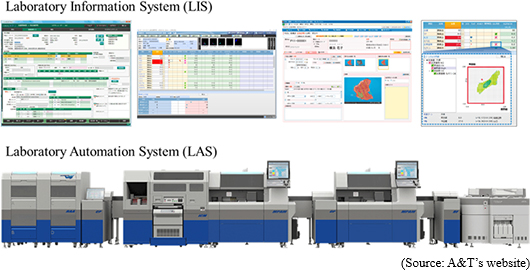 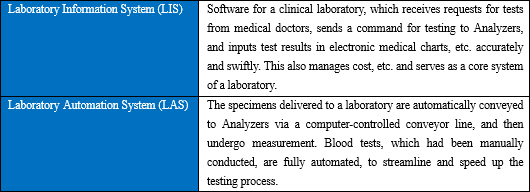 It is expected that the installation of LAS will decrease the necessary number of workers from 7-8 to about 2, and the necessary time of testing from 90 min. to 30-40 min.
Through the introduction of LIS, it became possible to put together the data of test results, which had been printed out for each test item, and give feedback to medical doctors swiftly and accurately. In addition, the data mining function is helpful for reducing the number of times of abnormal value retesting and the duration of testing.
(Commercial distribution)
*Inside Japan
Targeting the laboratories of medium and large-sized hospitals, the sales division of A&T Corporation sells LIS in cooperation with hospital information system manufacturers, including Hitachi, IBM, and Fujitsu, and LAS in cooperation with large-size clinical chemistry and immunoassay analyzer manufacturers, including Hitachi, Toshiba, and JEOL, as comprehensive solutions *.
*For the details of comprehensive solutions, see the section "1-5 Characteristics and Strengths."
*Outside Japan
Previously, the company has been selling LAS directly in Korea, China, etc., but in China it has started OEM supply. In the United States, OEM sales of blood aliquoting instruments, which are the main components in LAS, are made to partner companies.
(Business model)
In addition to the maintenance service of LIS and LAS after their installation, the company can connect additional systems, customize the system, and so on for LIS, and can offer maintenance services, sell supplies, and so on for LAS. For both of the systems, stable sales can be expected.
Like Analyzers, clients are rarely motivated to shift to other manufacturer's equipment, considering usability, data continuity, etc. The price range per transaction is 10 to 50 million yen for LIS, and 10 to 100 million yen for LAS.
(Major enterprises in this field)
LIS: Sysmex CNA (subsidiary of Sysmex), local vendors, etc.
LAS: IDS (unlisted), Hitachi-Aloka (unlisted), Siemens, etc.
2. Development systems
The company has organized separate groups for electricity, machinery, chemistry and information systems, in order to apply elementary technologies cultivated over many years to a wide range of product development.
The company is developing products for offering comprehensive solutions related to C.A.C.L. beyond product categories.
About 70 staff members are employed at the headquarters and Shonan Office.
The research and development cost for the term ended Dec. 2017 was 1,093 million yen, and the R&D to sales ratio was 10.5%. Although intensive investment took place during the term ended Dec. 2017, the company will continue to actively pursue R&D in the future, with a target of around 10% of R&D to sales ratio.
3. Production systems
There are two production sites: Shonan Factory, in Kanagawa Prefecture, for manufacturing some clinical reagents and supplies and Esashi Factory, in Iwate Prefecture, for producing equipment, Laboratory Automation System (LAS) and some clinical reagents.
The company manufactures high-quality, safe products with advanced equipment under rigorous management. In cooperation with the development section, the company is striving to improve quality and streamline operation.
In order to develop the foundation for expanding sales further, the company will construct a new building with a total floor area of 7,300 m2 at Esashi Factory by investing 1.7 billion yen in August 2017.The Company strengthens capabilities considerably through this construction.
4. Sales routes and methods
As mentioned above, A&T Corporation sells its products to client hospitals via 8 branches in Japan, by utilizing its capability of proposing comprehensive solutions.
Outside Japan, the company supplies products to overseas clients and dealers including Siemens through domestic OEM partners such as JEOL.
To expand its business scale by supplying products as an OEM like this is the basic strategy, and the company concentrates on the diversification of OEM clients.
The direct overseas sales to overseas clients and dealers and its ratio for the term ended Dec. 2017 were about 100 million yen and 9.3%, respectively.
But, as the ratio of virtual overseas sales, including the (estimated) overseas sales via domestic OEM clients, for the term ended Dec. 2015 for the term ended Dec. 2016, and for the term ended Dec. 2017 was 23.4%, 24.7%, 27.5% respectively, the ratio of overseas sales is in upward momentum. In the medium term, the company aims to increase the ratio to over 50%.
It is expected that the installation of LAS will decrease the necessary number of workers from 7-8 to about 2, and the necessary time of testing from 90 min. to 30-40 min.
Through the introduction of LIS, it became possible to put together the data of test results, which had been printed out for each test item, and give feedback to medical doctors swiftly and accurately. In addition, the data mining function is helpful for reducing the number of times of abnormal value retesting and the duration of testing.
(Commercial distribution)
*Inside Japan
Targeting the laboratories of medium and large-sized hospitals, the sales division of A&T Corporation sells LIS in cooperation with hospital information system manufacturers, including Hitachi, IBM, and Fujitsu, and LAS in cooperation with large-size clinical chemistry and immunoassay analyzer manufacturers, including Hitachi, Toshiba, and JEOL, as comprehensive solutions *.
*For the details of comprehensive solutions, see the section "1-5 Characteristics and Strengths."
*Outside Japan
Previously, the company has been selling LAS directly in Korea, China, etc., but in China it has started OEM supply. In the United States, OEM sales of blood aliquoting instruments, which are the main components in LAS, are made to partner companies.
(Business model)
In addition to the maintenance service of LIS and LAS after their installation, the company can connect additional systems, customize the system, and so on for LIS, and can offer maintenance services, sell supplies, and so on for LAS. For both of the systems, stable sales can be expected.
Like Analyzers, clients are rarely motivated to shift to other manufacturer's equipment, considering usability, data continuity, etc. The price range per transaction is 10 to 50 million yen for LIS, and 10 to 100 million yen for LAS.
(Major enterprises in this field)
LIS: Sysmex CNA (subsidiary of Sysmex), local vendors, etc.
LAS: IDS (unlisted), Hitachi-Aloka (unlisted), Siemens, etc.
2. Development systems
The company has organized separate groups for electricity, machinery, chemistry and information systems, in order to apply elementary technologies cultivated over many years to a wide range of product development.
The company is developing products for offering comprehensive solutions related to C.A.C.L. beyond product categories.
About 70 staff members are employed at the headquarters and Shonan Office.
The research and development cost for the term ended Dec. 2017 was 1,093 million yen, and the R&D to sales ratio was 10.5%. Although intensive investment took place during the term ended Dec. 2017, the company will continue to actively pursue R&D in the future, with a target of around 10% of R&D to sales ratio.
3. Production systems
There are two production sites: Shonan Factory, in Kanagawa Prefecture, for manufacturing some clinical reagents and supplies and Esashi Factory, in Iwate Prefecture, for producing equipment, Laboratory Automation System (LAS) and some clinical reagents.
The company manufactures high-quality, safe products with advanced equipment under rigorous management. In cooperation with the development section, the company is striving to improve quality and streamline operation.
In order to develop the foundation for expanding sales further, the company will construct a new building with a total floor area of 7,300 m2 at Esashi Factory by investing 1.7 billion yen in August 2017.The Company strengthens capabilities considerably through this construction.
4. Sales routes and methods
As mentioned above, A&T Corporation sells its products to client hospitals via 8 branches in Japan, by utilizing its capability of proposing comprehensive solutions.
Outside Japan, the company supplies products to overseas clients and dealers including Siemens through domestic OEM partners such as JEOL.
To expand its business scale by supplying products as an OEM like this is the basic strategy, and the company concentrates on the diversification of OEM clients.
The direct overseas sales to overseas clients and dealers and its ratio for the term ended Dec. 2017 were about 100 million yen and 9.3%, respectively.
But, as the ratio of virtual overseas sales, including the (estimated) overseas sales via domestic OEM clients, for the term ended Dec. 2015 for the term ended Dec. 2016, and for the term ended Dec. 2017 was 23.4%, 24.7%, 27.5% respectively, the ratio of overseas sales is in upward momentum. In the medium term, the company aims to increase the ratio to over 50%.
 【1-5 Characteristics and strengths】
◎ Capability of proposing comprehensive solutions
A&T Corporation handles products mainly for electrolyte and glucose tests, and does not handle large products for analyzing other tests. However, client hospitals need to install a variety of testing instruments in their clinical laboratories.
To meet their needs, the Laboratory Automation System (LAS) has an automatic conveyor line that is compatible with not only its own products, but also other manufacturers' instruments.
There are few manufacturers that possess technologies for producing systems for connecting their own products and other manufacturers' products freely and conveying them. Accordingly, the company occupies about 30% of the Japanese market.
The sales staff of the company not only delivers equipment, but also proposes a layout for the most efficient testing with 3D CAD or the like, while considering the area and shape of a laboratory.
All above, the company can offer optimal one-stop solutions for preparing necessary products in a laboratory, installing and operating equipment while proposing a layout. This is highly evaluated by client hospitals.
◎ Advanced technologies in specific fields
A&T Corporation handles products mainly for "electrolyte tests" and "glucose tests." Especially, its advanced technology for electrolyte analyzers can be verified by the fact that its products are supplied to JEOL, which is a leading manufacturer of measurement devices, including medical instruments, and Siemens, which is a large global company.
As mentioned in the section of the market environment, Japanese medical Analyzers is highly competent in the world, and A&T Corporation contributes to the competitiveness of Japanese products.
【1-6 ROE analysis】 【1-5 Characteristics and strengths】
◎ Capability of proposing comprehensive solutions
A&T Corporation handles products mainly for electrolyte and glucose tests, and does not handle large products for analyzing other tests. However, client hospitals need to install a variety of testing instruments in their clinical laboratories.
To meet their needs, the Laboratory Automation System (LAS) has an automatic conveyor line that is compatible with not only its own products, but also other manufacturers' instruments.
There are few manufacturers that possess technologies for producing systems for connecting their own products and other manufacturers' products freely and conveying them. Accordingly, the company occupies about 30% of the Japanese market.
The sales staff of the company not only delivers equipment, but also proposes a layout for the most efficient testing with 3D CAD or the like, while considering the area and shape of a laboratory.
All above, the company can offer optimal one-stop solutions for preparing necessary products in a laboratory, installing and operating equipment while proposing a layout. This is highly evaluated by client hospitals.
◎ Advanced technologies in specific fields
A&T Corporation handles products mainly for "electrolyte tests" and "glucose tests." Especially, its advanced technology for electrolyte analyzers can be verified by the fact that its products are supplied to JEOL, which is a leading manufacturer of measurement devices, including medical instruments, and Siemens, which is a large global company.
As mentioned in the section of the market environment, Japanese medical Analyzers is highly competent in the world, and A&T Corporation contributes to the competitiveness of Japanese products.
【1-6 ROE analysis】
 The company maintained a double-digit ROE in the term ended Dec. 2017 as well. The estimated ratio of net income to sales for the term ended Dec. 2018 is 5.6%.
The company maintained a double-digit ROE in the term ended Dec. 2017 as well. The estimated ratio of net income to sales for the term ended Dec. 2018 is 5.6%.
|
| Second Quarter of Fiscal Year December 2018 Earnings Results |
|
(1) Consolidated Business Results
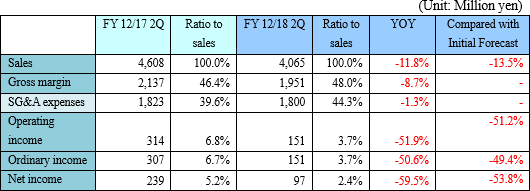 Sales and profit dropped.
Sales were 4,065 million yen, down 11.8% year on year. Sales dropped due to the decrease of sale of clinical testing equipment and systems and purchased products, but gross profit rate increased, as the decrease rate of gross profit was lower than that of sales due to the change of the sales composition and the intensive sale of original products.
Operating income was 151 million yen, down 51.9% year on year. Net income was 97 million yen, down 59.5%. The cost for transferring equipment from Shonan Factory to the new building of Esashi Factory was posted as extraordinary expenses. Neither sales nor profit reached the estimate.
The ratios of direct overseas sales and virtual overseas sales, on which the company puts importance for growth, were 9.3% and 28.3%, respectively. The ratio of virtual overseas sales exceeded that in the term ended Dec. 2017: 27.5%, indicating a steady increase.
(2) Sales of each product series Sales and profit dropped.
Sales were 4,065 million yen, down 11.8% year on year. Sales dropped due to the decrease of sale of clinical testing equipment and systems and purchased products, but gross profit rate increased, as the decrease rate of gross profit was lower than that of sales due to the change of the sales composition and the intensive sale of original products.
Operating income was 151 million yen, down 51.9% year on year. Net income was 97 million yen, down 59.5%. The cost for transferring equipment from Shonan Factory to the new building of Esashi Factory was posted as extraordinary expenses. Neither sales nor profit reached the estimate.
The ratios of direct overseas sales and virtual overseas sales, on which the company puts importance for growth, were 9.3% and 28.3%, respectively. The ratio of virtual overseas sales exceeded that in the term ended Dec. 2017: 27.5%, indicating a steady increase.
(2) Sales of each product series
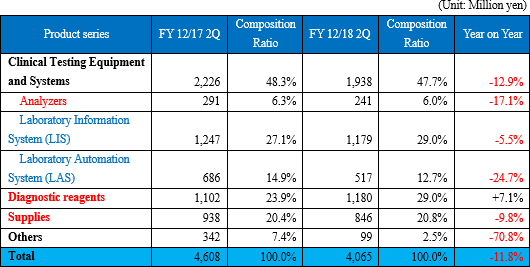 ◎ Clinical Testing Equipment and Systems
Sales declined 12.9% year on year.
The sales of analyzers decreased, as direct sales dropped although OEM sales were healthy.
The sales of the Laboratory Information System (LIS) dropped, as transactions for additional system connections and customization decreased although transactions for installation and renewal increased.
The sales of the Laboratory Automation System decreased, as there was some effect of the concentration of large-scale transactions in the first half of the previous year and order placement was delayed due to the inventory adjustment at affiliates in the U.S. although domestic transactions were favorable.
◎ Diagnostic reagents
Sales grew 7.1% year on year.
OEM sales inside and outside Japan were healthy.
◎ Supplies
Sales dropped 9.8% year on year, due to the recoil from the growth of demand expecting the replacement of old sensors with new ones at existing OEM clients at the end of the previous year.
◎ Others
Sales decreased 70.8% year on year.
As the company concentrated on the sale of its original products, the purchased products sales accompanying the transactions for LIS and LAS decreased.
(3) Financial condition and Cash Flow
◎ Main BS ◎ Clinical Testing Equipment and Systems
Sales declined 12.9% year on year.
The sales of analyzers decreased, as direct sales dropped although OEM sales were healthy.
The sales of the Laboratory Information System (LIS) dropped, as transactions for additional system connections and customization decreased although transactions for installation and renewal increased.
The sales of the Laboratory Automation System decreased, as there was some effect of the concentration of large-scale transactions in the first half of the previous year and order placement was delayed due to the inventory adjustment at affiliates in the U.S. although domestic transactions were favorable.
◎ Diagnostic reagents
Sales grew 7.1% year on year.
OEM sales inside and outside Japan were healthy.
◎ Supplies
Sales dropped 9.8% year on year, due to the recoil from the growth of demand expecting the replacement of old sensors with new ones at existing OEM clients at the end of the previous year.
◎ Others
Sales decreased 70.8% year on year.
As the company concentrated on the sale of its original products, the purchased products sales accompanying the transactions for LIS and LAS decreased.
(3) Financial condition and Cash Flow
◎ Main BS
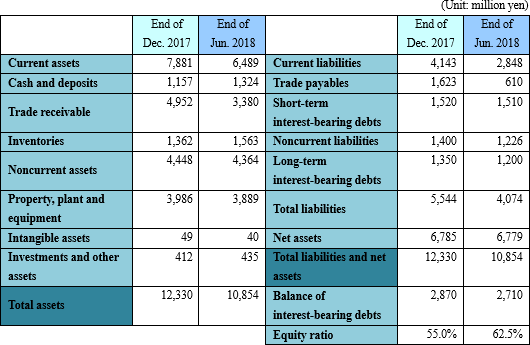 Current assets decreased 1,392 million yen from the end of the previous term, due to the decline in trade receivables, etc. Noncurrent assets were nearly unchanged. Total assets dropped 1,476 million yen from the end of the previous term to 10,854 million yen.
Total liabilities shrank 1,470 million yen from the end of the previous term to 4,074 million yen, due to the decline in short and long-term debts, etc.
Net assets were nearly unchanged.
As a result, equity ratio rose 7.5% from 55.0% at the end of the previous term to 62.5%.
◎ Cash Flow
Current assets decreased 1,392 million yen from the end of the previous term, due to the decline in trade receivables, etc. Noncurrent assets were nearly unchanged. Total assets dropped 1,476 million yen from the end of the previous term to 10,854 million yen.
Total liabilities shrank 1,470 million yen from the end of the previous term to 4,074 million yen, due to the decline in short and long-term debts, etc.
Net assets were nearly unchanged.
As a result, equity ratio rose 7.5% from 55.0% at the end of the previous term to 62.5%.
◎ Cash Flow
 Operating CF shrank, due to the decrease in trade payables, etc. The deficit of investment CF decreased, as the purchase of property, plant and equipment dropped because the enlargement of Esashi Factory was completed. Free CF increased. Financial CF became negative, because the repayments of short and long-term loans payable augmented. The cash position declined.
Operating CF shrank, due to the decrease in trade payables, etc. The deficit of investment CF decreased, as the purchase of property, plant and equipment dropped because the enlargement of Esashi Factory was completed. Free CF increased. Financial CF became negative, because the repayments of short and long-term loans payable augmented. The cash position declined.
|
| Fiscal Year December 2018 Earnings Estimates |
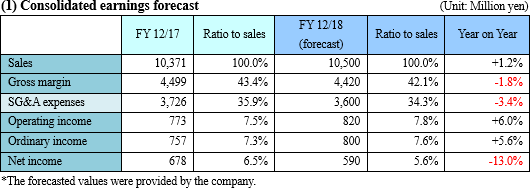 No change to the forecast of growth in sales and profit. Estimated dividends and sales of each product category revised.
There is no revision to the full-year forecast.
Sales are estimated to be 10.5 billion yen, up 1.2% year on year. The sales of clinical testing equipment and systems were generally favorable, particularly the Laboratory Automation System. The sales of supplies and purchased products, which experienced an increase in the previous term, are expected to decrease.
Gross profit rate is estimated to decline 1.3 points, and gross profit is also estimated to decline due to cost increases caused by increases in overseas transactions for the Laboratory Automation System, response to overseas regulation of expendable sensors (RoHS directive: A directive by the EU concerning restriction of the use of certain hazardous substances in electrical and electronic equipment), increases in depreciation due to additional production facilities, etc.
Operating income is expected to be 820 million yen, up 6.0% year on year. SG&A expenses are estimated to decrease 3.4%, as the previous term's intensive investments in the development of subsystems for the Laboratory Information System have finished.
The ratio of direct overseas sales is estimated to rise from 9.3% in the previous term to over 10%. No change to the forecast of growth in sales and profit. Estimated dividends and sales of each product category revised.
There is no revision to the full-year forecast.
Sales are estimated to be 10.5 billion yen, up 1.2% year on year. The sales of clinical testing equipment and systems were generally favorable, particularly the Laboratory Automation System. The sales of supplies and purchased products, which experienced an increase in the previous term, are expected to decrease.
Gross profit rate is estimated to decline 1.3 points, and gross profit is also estimated to decline due to cost increases caused by increases in overseas transactions for the Laboratory Automation System, response to overseas regulation of expendable sensors (RoHS directive: A directive by the EU concerning restriction of the use of certain hazardous substances in electrical and electronic equipment), increases in depreciation due to additional production facilities, etc.
Operating income is expected to be 820 million yen, up 6.0% year on year. SG&A expenses are estimated to decrease 3.4%, as the previous term's intensive investments in the development of subsystems for the Laboratory Information System have finished.
The ratio of direct overseas sales is estimated to rise from 9.3% in the previous term to over 10%.
 Commemorating the 40th anniversary of establishment of the company, the annual dividend is to be 24 yen/share. The estimated payout ratio is 25.5%.
Commemorating the 40th anniversary of establishment of the company, the annual dividend is to be 24 yen/share. The estimated payout ratio is 25.5%.
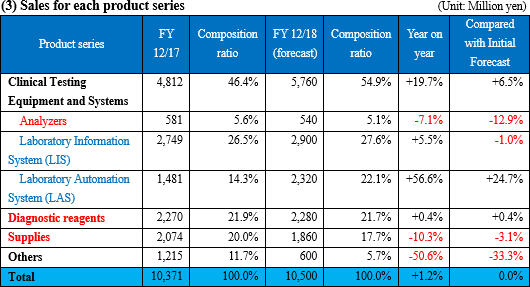 The estimated total sales of 10.5 billion yen has not been revised, but the breakdown of that is revised as follows:
The estimated total sales of 10.5 billion yen has not been revised, but the breakdown of that is revised as follows:
 The direct sales of analyzers are estimated to decline, although OEM sales were healthy like in the first half. The direct sales of analyzers are estimated to decline, although OEM sales were healthy like in the first half.
 The performance of LIS was almost as forecasted, and the company will keep striving to increase new transactions in the second half. The performance of LIS was almost as forecasted, and the company will keep striving to increase new transactions in the second half.
 As for LAS, it is expected that large-scale transactions will increase inside and outside Japan, especially in the fourth quarter. As for LAS, it is expected that large-scale transactions will increase inside and outside Japan, especially in the fourth quarter.
 Supplies are expected to experience a decline in sales due to OEM inventory adjustments made in order to comply with overseas regulations (RoHS directive) on expendable sensors. Supplies are expected to experience a decline in sales due to OEM inventory adjustments made in order to comply with overseas regulations (RoHS directive) on expendable sensors.
 In the previous term, sales of purchased products increased, but this year the company will raise the sales ratio for original products. In the previous term, sales of purchased products increased, but this year the company will raise the sales ratio for original products.
|
| Medium-Term Management Plan (FY Dec. 2018-FY Dec. 2020) |
|
(1) Outline of Medium-Term Management Plan
In May 2018, as a celebration of the 40th anniversary of its founding, and in anticipation of its 50th anniversary in 2028, the company has formulated a three-year medium-term management plan starting this term.
Sales in the last three terms have been mostly unchanged, and ordinary income has declined after reaching a peak in FY Dec. 2015, but with the theme of "building a framework for sustainable growth," the company aims to "shift toward an increasing trend in sales and profits, and quickly recover ordinary income."
<Target Figures>
For the term ending Dec. 2020, the company mentioned "sales of 12 billion yen or greater, an ordinary income rate of over 10%, and an overseas direct sales ratio of 10% or more."
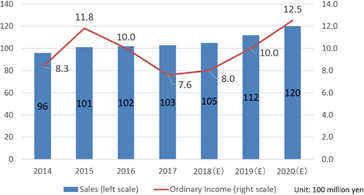 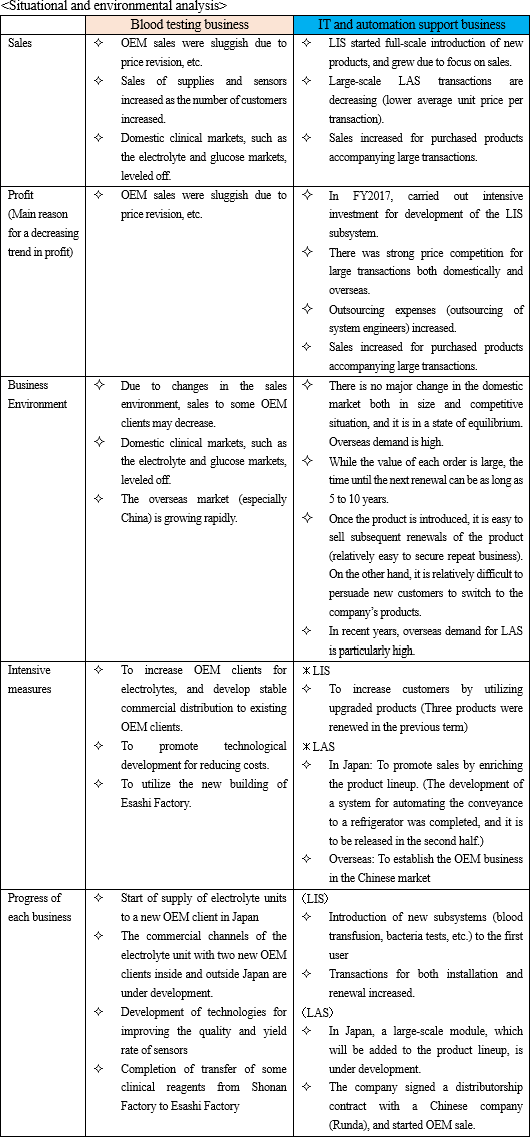 The company believes that overseas expansion is crucial for both businesses in order to achieve the objective.
The company believes that overseas expansion is crucial for both businesses in order to achieve the objective.
 ① Raise the ratio of original product sales and improve profitability.
In the previous term, purchased products sales grew, but this term, the company will strive to boost the ratio of original products sales, with the aim of raising gross profit rate. The gross profit rate for the first half was 48.0%, up 1.5% year on year.
② Strengthen development of business targeted at China and raise the ratio of overseas sales.
(Progress made so far)
In 2012, the company established a joint venture, to sell Analyzers (electrolyte units), and has conducted the OEM sales to one Chinese manufacturer, but considering that it is necessary to operate business in a more multifaceted manner, in order to cultivate the huge market, the company obtained a new business license for the joint venture in June 2016, and established a division for promoting the business in China, to develop a system for carrying out full-scale business in China, and opened an expatriates' office in Shanghai in September 2016.
As for Laboratory Automation System which the company regard as a central product, the core product, CLINILOG V4, was installed through direct sales in a large hospital in China for the first time in the previous term.
Meanwhile, the company has been seeking business partners for OEM sales, and it signed a distributor agreement with Shanghai Runda Medical Technology Co., Ltd. (hereinafter referred to as Runda Medical; Shanghai Stock Exchange Code: 603108.SS) as an OEM supplier. They agreed with the 2018 sales plan for the OEM package of LAS.
In parallel, the company started supporting the education of sales staff and service engineers of Runda Medical before the installation of equipment in China. It is considered important to develop an efficient system that would not cause the augmentation of costs.
(Strategies after this term)
Sales of the "Laboratory Automation System (LAS)" in China will focus on OEM supply for Runda Medical. ① Raise the ratio of original product sales and improve profitability.
In the previous term, purchased products sales grew, but this term, the company will strive to boost the ratio of original products sales, with the aim of raising gross profit rate. The gross profit rate for the first half was 48.0%, up 1.5% year on year.
② Strengthen development of business targeted at China and raise the ratio of overseas sales.
(Progress made so far)
In 2012, the company established a joint venture, to sell Analyzers (electrolyte units), and has conducted the OEM sales to one Chinese manufacturer, but considering that it is necessary to operate business in a more multifaceted manner, in order to cultivate the huge market, the company obtained a new business license for the joint venture in June 2016, and established a division for promoting the business in China, to develop a system for carrying out full-scale business in China, and opened an expatriates' office in Shanghai in September 2016.
As for Laboratory Automation System which the company regard as a central product, the core product, CLINILOG V4, was installed through direct sales in a large hospital in China for the first time in the previous term.
Meanwhile, the company has been seeking business partners for OEM sales, and it signed a distributor agreement with Shanghai Runda Medical Technology Co., Ltd. (hereinafter referred to as Runda Medical; Shanghai Stock Exchange Code: 603108.SS) as an OEM supplier. They agreed with the 2018 sales plan for the OEM package of LAS.
In parallel, the company started supporting the education of sales staff and service engineers of Runda Medical before the installation of equipment in China. It is considered important to develop an efficient system that would not cause the augmentation of costs.
(Strategies after this term)
Sales of the "Laboratory Automation System (LAS)" in China will focus on OEM supply for Runda Medical.
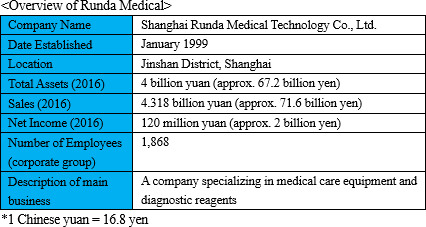 In addition to meeting the needs for laboratory automation in China, A&T sells the OEM package "CLINILOG V4" to Runda Medical in order to improve business efficiency.
Originally, sales proposals for LAS required changing specifications and customization according to the needs of the supplier, but attempting to meet every need can lead to a decline in profitability.
As such, the company will prepare a few fixed patterns of OEM products with fixed equipment that can be incorporated depending on the size of the laboratory where V4 is installed.
With this packaging, in addition to reducing labor for design changes, development, and improvement for each hospital, stable sales and production planning become possible, and sales of the "Laboratory Automation System (LAS)" in China become more efficient.
Utilizing Runda Medical's customer base and service structure, the company aims to expand sales of V4 in the Chinese market.
In addition, in hopes of acquiring new OEM clients for analyzers (electrolyte unit), the company will continue negotiations with Chinese analyzer manufacturers.
③ Strengthen the link between development and manufacturing, and create a system for developing and producing stable, high-quality products.
In Apr. 2018, the transfer of equipment for manufacturing some clinical reagents from Shonan Factory to Esashi Factory was completed. Through the construction of the new building of Esashi Factory, the production areas for instruments and some clinical reagents expanded about 1.7 times and about 2.5 times, respectively. The vacant space of Shonan Factory is to be repurposed as the areas for developing and producing supplies.
Then, the company will keep striving to improve manufacturing environment, yield rate, and so on, in order to cement the cooperation between development and manufacturing, and establish systems for developing and producing high-quality products stably.
In July 2018, the company started shipping clinical reagents from Esashi Factory.
④ Thoroughly examine work-style reforms and human resource development.
For reforming work-style and human resource development, the company is developing comprehensive educational programs.
In April 2018, the company adopted a system for promoting limited-term quasi employees to unlimited-term employees (region-limited full-time employees). Then, an employment environment will be developed so that employees will be able to perform well for a long period of time, and the company will develop excellent personnel who possess advanced knowledge and skills.
In addition to meeting the needs for laboratory automation in China, A&T sells the OEM package "CLINILOG V4" to Runda Medical in order to improve business efficiency.
Originally, sales proposals for LAS required changing specifications and customization according to the needs of the supplier, but attempting to meet every need can lead to a decline in profitability.
As such, the company will prepare a few fixed patterns of OEM products with fixed equipment that can be incorporated depending on the size of the laboratory where V4 is installed.
With this packaging, in addition to reducing labor for design changes, development, and improvement for each hospital, stable sales and production planning become possible, and sales of the "Laboratory Automation System (LAS)" in China become more efficient.
Utilizing Runda Medical's customer base and service structure, the company aims to expand sales of V4 in the Chinese market.
In addition, in hopes of acquiring new OEM clients for analyzers (electrolyte unit), the company will continue negotiations with Chinese analyzer manufacturers.
③ Strengthen the link between development and manufacturing, and create a system for developing and producing stable, high-quality products.
In Apr. 2018, the transfer of equipment for manufacturing some clinical reagents from Shonan Factory to Esashi Factory was completed. Through the construction of the new building of Esashi Factory, the production areas for instruments and some clinical reagents expanded about 1.7 times and about 2.5 times, respectively. The vacant space of Shonan Factory is to be repurposed as the areas for developing and producing supplies.
Then, the company will keep striving to improve manufacturing environment, yield rate, and so on, in order to cement the cooperation between development and manufacturing, and establish systems for developing and producing high-quality products stably.
In July 2018, the company started shipping clinical reagents from Esashi Factory.
④ Thoroughly examine work-style reforms and human resource development.
For reforming work-style and human resource development, the company is developing comprehensive educational programs.
In April 2018, the company adopted a system for promoting limited-term quasi employees to unlimited-term employees (region-limited full-time employees). Then, an employment environment will be developed so that employees will be able to perform well for a long period of time, and the company will develop excellent personnel who possess advanced knowledge and skills.
|
| Conclusions |
|
As for the full-scale OEM supply in China, which was mentioned in the previous report as a noteworthy topic, the OEM package has been released based on the 2018 sales plan agreed by the company and Runda Medical, and its sale and the development of a support system are progressing well. Inside Japan, the equipment for some clinical reagents has been transferred to Esashi, and the ratio of sales of original products was raised to improve productivity and profitability. Like this, business strategies have been progressing steadily.
In the first half, sales and profit declined year on year, but the full-year earnings forecast has not been revised. From the second half, it is expected that the above-mentioned business strategies will produce some effects. Particularly, we have strong expectations for the business growth in China.
|
| <Reference: Regarding corporate governance> |
 ◎ Corporate Governance Report
Last Update: March 30 2018.
<Basic policy>
As a top priority, our company aims to secure the effectiveness of corporate governance and actualize fair business administration by putting importance on the transparency, fairness, and speed of decision making and business execution. In addition, we adopted the system of audit and supervisory committee in order to separate the supervision and execution of business administration, actualize highly transparent management, and streamline the decision-making process of the board of directors.
<Reasons for Non-compliance with the Principles of the Corporate Governance Code (Excerpts)>
As a JASDAQ listed company, the company fully follows the 5 items of basic principles of the corporate governance code. ◎ Corporate Governance Report
Last Update: March 30 2018.
<Basic policy>
As a top priority, our company aims to secure the effectiveness of corporate governance and actualize fair business administration by putting importance on the transparency, fairness, and speed of decision making and business execution. In addition, we adopted the system of audit and supervisory committee in order to separate the supervision and execution of business administration, actualize highly transparent management, and streamline the decision-making process of the board of directors.
<Reasons for Non-compliance with the Principles of the Corporate Governance Code (Excerpts)>
As a JASDAQ listed company, the company fully follows the 5 items of basic principles of the corporate governance code.
Disclaimer
This report is intended solely for information purposes, and is not intended as a solicitation for investment. The information and opinions contained within this report are made by our company based on data made publicly available, and the information within this report comes from sources that we judge to be reliable. However, we cannot wholly guarantee the accuracy or completeness of the data. This report is not a guarantee of the accuracy, completeness or validity of said information and opinions, nor do we bear any responsibility for the same. All rights pertaining to this report belong to Investment Bridge Co., Ltd., which may change the contents thereof at any time without prior notice. All investment decisions are the responsibility of the individual and should be made only after proper consideration.Copyright (C) 2018 Investment Bridge Co., Ltd. All Rights Reserved. |


